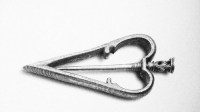Heart Shaped Fire Steels...not just for girls!
Posted on
Re-lighting the flame of passion…..
Why Heart shaped traditional fire steels make the perfect striker and are not just for the girls….
Many, many 1000's of years ago, back in the Stone Age, man discovered it was the sparks from Iron Pyrite that produced the sparks and not the flint. Perhaps by playing with Iron Pyrite, man created Iron and thus was born the Iron Age. Then experimented with iron, he discovered that through heating it in a certain way and then rapidly cooling it, the first Fire Steel came into existence, producing hotter and better sparks then the Pyrite used to create the fire in the first place!! Throughout the centuries man created and designed more and more elaborate shaped fire steels. From their humble beginnings of a straight coarsely shaped piece of metal to the classic and still popular, to this day, the classic ‘C’ shaped version. The most creative era for the Fire Steels was between the 15th to the 18th century, when advances in metal works really took off with trade between countries and the influence of other cultures.
So why the Heart shaped Fire steel then?.....
Well in the middle ages, simple designs were sold in markets places, but as society’s demands for fire grew, the fire steel became an important part of the house hold and would have been kept in a tinderbox near the hearth where it would be nice and warm to keep the tinderbox and thus the tinder dry. During the 17th century, or there about, the ‘Heart’ shaped Fire Steels started to become more and more popular due to the advancement of metal and refinements of Fire Steel design.
The ‘Heart’ shaped fire steel has a natural curve - that makes the prefect edge for striking it against a piece of flint - rather than a straight edge, which is more awkward to use and may cause uncontrollable bouncing as the steel and flint impact each other. Any uncontrolled bouncing of this kind is more likely to damage the delicate and brittle edge of the flint in the initial shock of a sudden impact between the two items and since it is the top of the curve that produces the best spark when striking, due to the high speeds and pressures at that point of the strike, it is best to create gentle initial contact with the flint, with a natural increase in pressure as the strike progresses, which can only really be achieved by a simple fluid and gentle arc starting from the bottom of the fire steel which progresses to the top. A natural curve therefore allows steel to be shaved off the Fire Steel by the sharp edge of the flint without causing excessive damage to the flint whilst doing so.
Why it keeps the flame of passion alive….
 In or around the 17th-18th Century, fire steel designs were becoming more elaborate and ornate. As this drawing of a mid 17th centuary Fire Steel shows. People also started to wear them on a chatelaine (neck chain) or they become incorporated into other fire lighting instruments.
In or around the 17th-18th Century, fire steel designs were becoming more elaborate and ornate. As this drawing of a mid 17th centuary Fire Steel shows. People also started to wear them on a chatelaine (neck chain) or they become incorporated into other fire lighting instruments.
They were often given as a gift between lovers, which would have been beautifully designed with added bits of sliver incorporated into the deigns, which would have been worn around the neck … what better way can you tell someone how much you love them than by gifting to them a ‘Heart’ fire steel, which symbolically represents the eternal ‘flame of desire and love’ close to your loved one’s heart …
